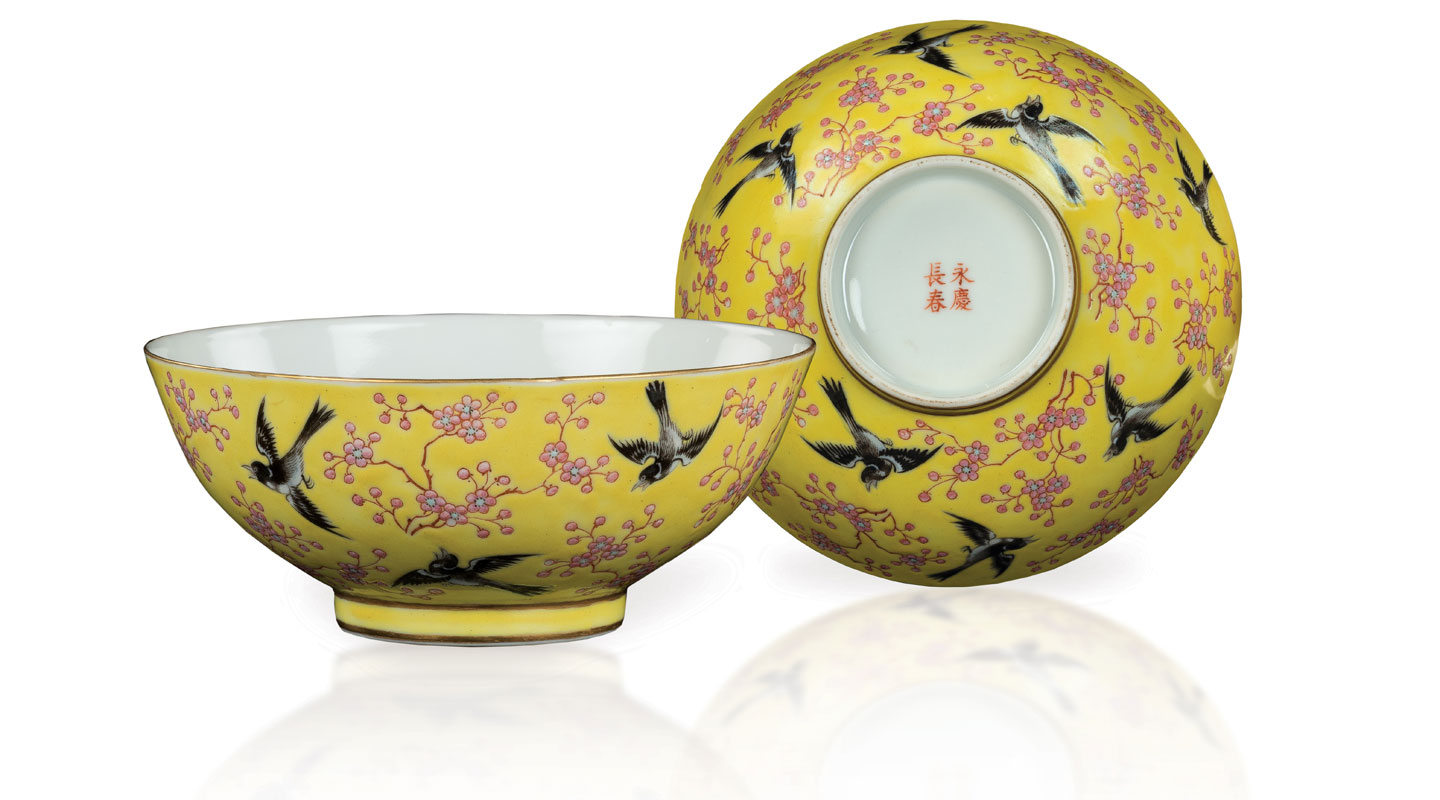Dear readers, With the launch of e-newsletter CUHK in Focus, CUHKUPDates has retired and this site will no longer be updated. To stay abreast of the University’s latest news, please go to https://focus.cuhk.edu.hk. Thank you.
Living Happily Ever After…

Items bearing names which rhyme with words of auspicious connotation make popular motifs in Chinese art, the pair of bowls shown here being a vivid illustration. On the famille-rose yellow ground are magpies (xique) and prunus blossoms (meihua). While xi means happiness ‘喜’, the magpie is considered a bird bringing good tidings. The prunus blossoms signalling the onset of spring are emblematic of robust growth. The Chinese word for eyebrow ‘眉’ also pronounces as mei. So the scene of magpies flying among prunus blossoms alludes to the Chinese idiom ‘xishang meishao’, which literally means ‘joy flooding up to the eyebrows’. At the bottom of each bowl is a mark of four characters ‘yongqing changchun’—‘celebrating everlasting spring’. The mark was written in red, a colour of joy and celebration in the Chinese context.
The jocund mood of well-wishing was created to celebrate the imperial wedding of Qing Tongzhi Emperor who was on the throne for only 13 years. According to a memorandum issued by a provincial official of Jiangxi, in the sixth year of Tongzhi’s era, the Qing government ordered the imperial kilns to produce more than 10,000 wedding porcelain items in 24 selections, each consisting close to 700 pieces of bowls, plates, cups and spittoons. The ‘famille-rose with magpies and prunus decorations on a yellow glaze ground’ was one of these selections.
With deep rounded sides rising from a short tapering foot to an everted rim, both gilded, the bowls are elegant and aristocratic. Decoration with gold rimming was first found in Chinese porcelains during the Five Dynasties in the 10th century, and the skill was extensively adopted in the Ming and Qing dynasties. The bowls’ interiors were glazed in white. The yellow glaze ground on the exteriors discloses the prestigious status of the user, as yellow in Chinese is huang, which is homophonous to ‘皇’ meaning ‘royalty’. That is why the use of yellow glaze on porcelains was monopolized by the imperial family in the Ming and Qing dynasties.
Jingdezhen in Jiangsu was renowned for its exquisite porcelain products and home to a number of imperial kilns, but many craftsmen had fled the place since warfare broke out in the days of the preceding Xianfeng Emperor. However, upon receiving the order, the imperial kiln craftsmen still gave their best to produce wedding porcelains with such refinement that the batch ranked top in quality among the products in the Tongzhi era.
The rich colours of the bowls were evenly glazed to form a warm lustre. The magpies were drawn in fine strokes and the blossoms in simple lines. They were evenly spaced against the bright yellow ground, and the stamens of the flowers were accentuated with light blue dots which stood out from the bowl surface to give a three-dimensional presence.
Early in the 11th year of Tongzhi’s era, the Emperor appointed Lady Alute, daughter of a Hanlin Academy official, to be his empress titled Xiaozheyi. The imperial wedding ceremony that took place seven months later lasted for two days on a scale most grand and extravagant, with thoroughly-observed rituals and everything custom-made. Tongzhi, who had been enthroned at the tender age of six, had never really governed the country. Overseeing national affairs practically behind the curtain were two Empress Dowagers—Ci’an and Cixi, the latter being his mother. It was said that Empress Xiaozheyi was dear to Tongzhi, but since she failed to win the favour of Cixi, he was forced to detach himself and finally turned to seek carnal pleasure in the brothels. He died in the last month of his 13th year in throne at the age of 19, followed by the ‘sudden death’ of his beloved queen 75 days later. Spring did not last long for the young couple.
The pair of bowls, fired to commemorate an imperial matrimony, has outlived the fragility of youth and survived generations of turmoil and changes. It remains a symbol of love and vows and is now housed in the University’s Art Museum.
This article was originally published in No. 494, Newsletter in Mar 2017.